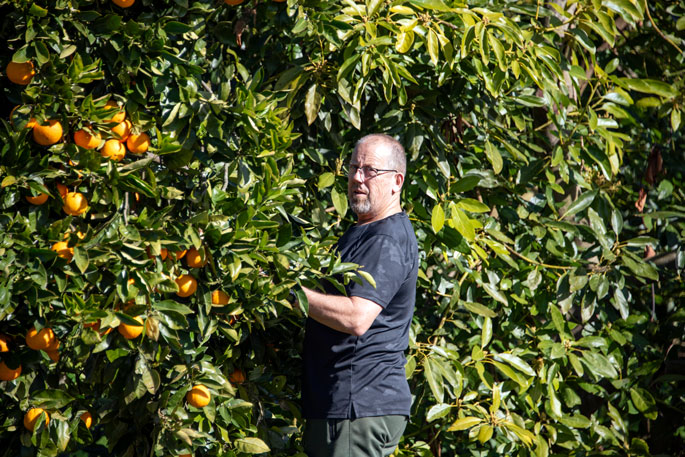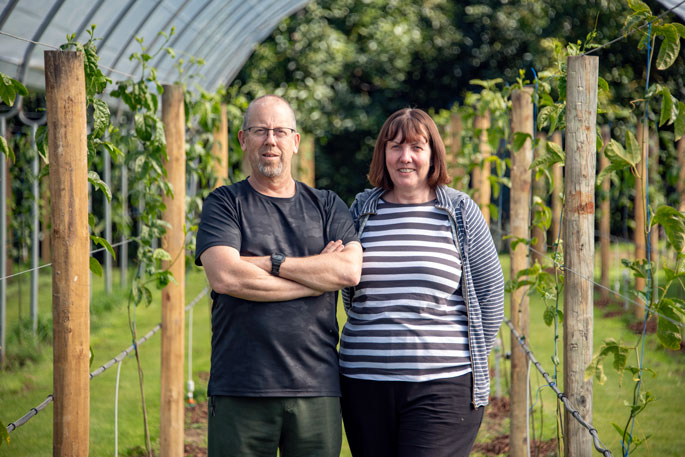Bay of Plenty orchard owners, Simone and Wayne Fenton, moved into horticulture after their three children had grown up, but both came from agricultural beginnings.
Simone grew up on a dairy farm in Putaruru and Wayne is from Tokoroa and has dairy farmed and worked at Kinleith Mill.
They moved to the BOP in the late 1990s in search of a better lifestyle for their family and brought the children up in Tauranga.
Simone was a clerical worker and Wayne worked for Firestone in Tauranga and has been a shift worker for a resin manufacturing company for the past 19 years.
“We bought our first orchard in Te Puke in 2015, and we hadn’t done anything like that before,” says Wayne.
“We approached people we thought could help and we were blown away by how helpful people have been, and we got so much good advice over the years.”
Simone says that the practices are the same but as people get to know their land they adapt their own ways to suit the land.
Whakamarama fruit bowl
The Fentons bought their current 2.6ha Whakamarama property in April 2021.
“We called it a fruit bowl as it has a bit of everything as the last owners went around the farmer’s markets selling their fruit. We grow fruit for export, so we decided to simplify things and pick two or three fruits and do them well,” says Wayne.
Simone carries out the orchard work and Wayne joins her on his days off.
“It’s just the two of us doing the day-to-day work but seasonally we use contractors to prune, pick, and take the bins of harvested avocados to the packhouse for export,” says Simone.
When the couple bought the property it coincided with the bottom dropping out of the avocado market with the expectation that this situation would last for the next five years.
“We’ve got 200 avocado trees on the property, and some are 35 years old. We will stay in avocado growing but we’ll ensure the trees are kept low so they are easier to manage, reducing labour outgoings,” says Simone.
They have also removed trees, such as plums and citrus as they “can’t compete with the bulk buyers”. Tamarillos grow well on the property, and they are considering expanding them.
 Passionfruit being grown under plastic canopies in Whakamarama. Photo: Catherine Fry.
Passionfruit being grown under plastic canopies in Whakamarama. Photo: Catherine Fry.
There were 150 passionfruit vines growing under plastic canopies, where they aren’t exposed to frost, and they flourished during Simone and Wayne’s first season on the orchard.
“We planted another 150 or so passionfruit vines in March 2024 and expect them to fruit for the first time in January 2025.”
Some of the vines were grown from seeds from their existing plants and some were from cuttings from parent plants that were thriving on the land.
Learning to grow passionfruit
“Once again we have taught ourselves how to grow them and once again people have been very helpful with information and advice,” says Wayne.
Mulch from our avocados is used around the passionfruit vines and a ground sprinkler system is used about once a week in winter and often daily in the summer, but, Wayne says, “they don’t like wet feet”.
Foliar fungicide sprays are used to control fungal diseases such Fusarium which can take out a crop and Phytophthora which forms in the vine’s roots. The vines are sprayed for pests such as mites and passion vine hopper.
Each plant will produce for about seven years although they slow down in their last three or four years. They are treated like a vine and pruned to keep the canopy open and healthy.
 The few remaining citrus trees are for the family. Photo: Catherine Fry.
The few remaining citrus trees are for the family. Photo: Catherine Fry.
Fruit falls when it is ready and needs to be picked up, graded and packed every morning.
“We grow Passiflora edulis, which is the most popular one. They need to be planted in rows from north to south and they like warmth when flowering. We were very fortunate that Cyclone Gabrielle went straight over our property as we are nestled into an east-facing hillside,” says Wayne.
Depending on the weather, Wayne and Simone can sometimes be picking passionfruit from January to May.
This coincides with the off-season for passionfruit in the United States and there is a good market for New Zealand passionfruit over there.
“With very few passionfruit growers currently in New Zealand, we can barely meet the local demand, and the export market will take whatever we have available after that. There’s definitely room for growth in this industry.”
The Fentons are members of the New Zealand Passionfruit Growers Association Inc. where the growers work together to improve their knowledge with expert advice and encourage anyone wishing to enter the industry to contact the organisation for information.



0 comments
Leave a Comment
You must be logged in to make a comment.